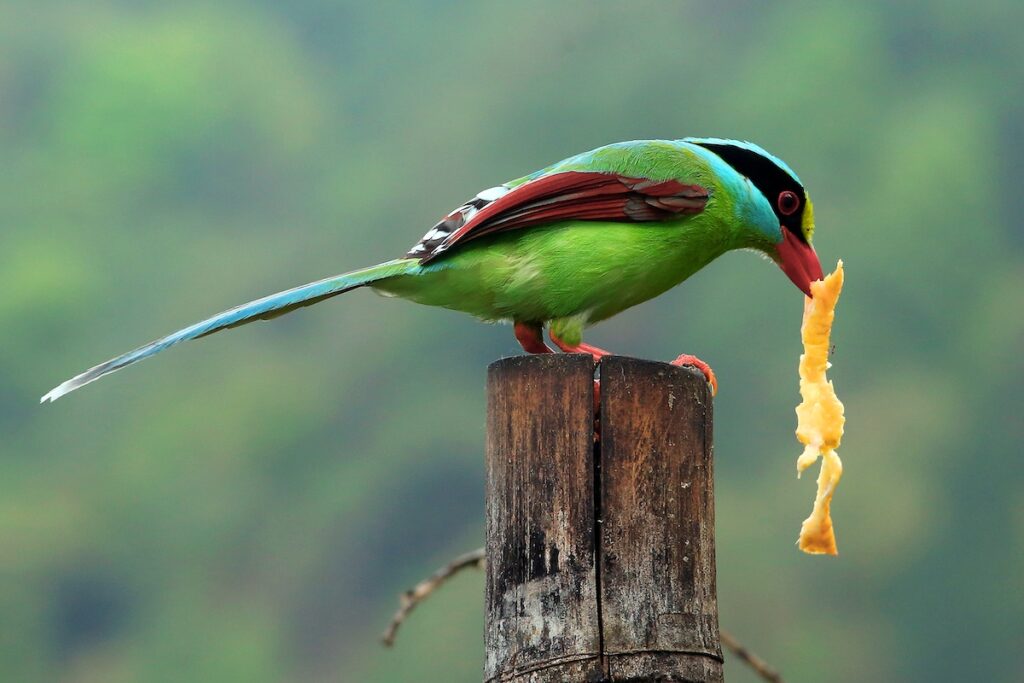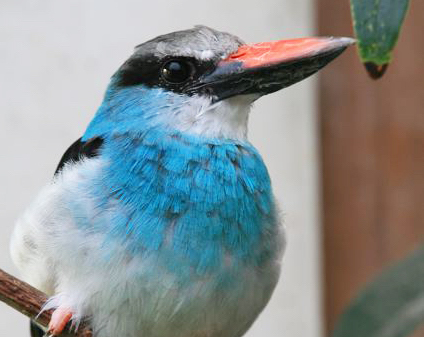…foreign softbills are for you! Expert breeder GARY BRALSFORD guides us through the extensive range of feeds, and describes in depth the régime for one species of kingfisher
FEEDING any livestock is as important as feeding ourselves. Variety and a balanced diet promote health and fitness in all living things. And softbill diets are no different.
A diet for foreign softbills has to have a base and for these species a Uni-Patee will provide this. There are several on the market, including Orlux, Slaats, Haith’s and Kiezebrink. All vary in quantity and whether they are bagged or in tubs. Prices have gone up this past 12 months, so it is advisable to shop around.
Normally, you feed this daily and start by removing the previous day’s remnants. It is important to clean the dishes before the feeds, and to supply only enough for the birds in that aviary. That way you avoid waste and are cost-efficient.
Papaya: a star food
Whatever species you have, fruit is beneficial. Favourites are pears, apple, grapes (not too many) and banana. A little orange on occasions, as well, but papaya I’d probably classify as a must – it brings plenty of health benefits.
Livefoods are a major consideration as well. Mealworms are the base food, with morio for larger species, black/brown crickets and locusts of all size, plus waxworms both normal and mini. For large jays or cissas the pachnoda grub is a must. Frozen foods such as pinkie maggot and buffalo worms make a fantastic addition. The Top Insect range from Essex Birds is well worth a look.
Some fanciers feed a few vegetables as well, such as sweetcorn or peas, plus broccoli florets and grated carrot. I also use grated cheddar cheese.
Seasonal variations
I have used a relative “austerity diet” from November through to March and have found that it helps to stimulate breeding at the end of that period, once the protein and livefoods are increased. For breeding I step up everything and add more vitamins. Personally I swear by TrioVit as my vitamin additive powder to go with livefood and any meat foods such as minced beef, pinkie mice, etc.
When livefoods are fed more often at the onset of the breeding season they often trigger the cock birds to display and the hens to start carrying materials. But getting the balance is key. Cock birds can become too aggressive and attack a hen if she is not at the same level of fitness.

Softbill feeds have developed massively over the past five years or so and most of the new feeds of “near-wild” mixes are coming out of the EU. Here are a few examples. Versele-Laga have an extensive range of pellets and Uni-Patee to choose from and these different mixes cater for most of the species of softbill available. Kiezebrink offer extruded pellet for small and large softbill. Their Zoo range of Mazuri pellets are particular good. The company has studied the market, talked to private collectors and zoos, and come up with a winning formula, although they can be expensive on some ranges.
Those softbills that take grass seeds or berries are in for a treat nowadays, as again the European bird-feed market has a wide range of fantastic products.
How to present food
Most of my feeding is from stainless steel bowls on swing feeders that are fitted into the doors. These I find are easy to clean and more hygienic than the alternatives. I try not to feed at floor level, to stop any slugs or snails getting at the foods. They are persistent, however, and may succeed. Obviously, don’t put feeds under the perches. There is nothing worse than expensive feeds being pooped on and having to bin them!
Editor Rob asked me to describe the best decision I’d taken in feeding my own softbills. It was when I specialised in kingfishers. You’d think fish would be the diet – but no, not at all! I kept the blue-breasted kingfisher (Halcyon malimbica) and fed fish sprats and lance fish. Big mistake. For one thing, they are forest, not river species. The fish they did occasionally eat got all over the place and stank. I had flies everywhere as well, plus white streaks of what came out the other end on walls and perches.
By contrast, the brown-hooded kingfisher (H. albiventris) was a lovely species to keep. My diet for this species was as follows:
– 40 per cent ox-heart strips or pinkie mice
– 30 per cent chopped day-old chicken strips (with a multivitamin powder added once per day: TrioVit or Nutrobal)
– 30 per cent livefood such as mealworms, winged flies (greenbottle), crickets, locusts, etc. If I tried a small lance fish, that would be taken. These kingfishers don’t actually dive into the water to take a fish, but fly onto the dish and pick it up, then go to a perch and batter it.
Pairs should be provided with more than one food dish in different locations, to minimise the potential for aggression over food. I recommend feeding twice a day and have noticed that kingfishers prefer to feed early morning and in the evening.
What about hand-rearing?
A friend tried to hand rear some brown-hooded after putting eggs in an incubator. (The parents had an habit of puncturing the eggs for some reason.) His hand-rearing advice was as follows:
“Most forest kingfishers can be hand-reared on 50 per cent ox-heart or pinkie mouse dipped in commercial rearing foods, with a multivitamin (TrioVit or Nutrobal) and calcium supplement added once a day. The remainder of the diet should consist of insects and fluff mice which have been cut into pieces.
“Initially, chicks should be fed hourly and provided with an artificial source of heat. Newly hatched chicks are kept at 36°C (96.8°F) and this is reduced by 1°C (1.8°F) per day until an ambient temperature of 24-26°C (75.2-78.8°F) is reached. By this time, the chicks will be half feathered, and feeding every two hours will be OK. All food is fed with tweezers, and chicks will usually take three food items per feed.
“The chicks are able to swallow quite large pieces of food. While their eyes are still closed, the food is touched on the side of the gape, and will be immediately eaten. Chicks can become aggressive when food is presented, and on occasions you have to separate them. When hungry the chicks will become very vocal.
“A strong plastic mesh is put in the bottom of the container so that their feet are not harmed. The vessel needs cleaning at least twice a day because of the smelly droppings.”
Forest kingfishers are a feeding challenge, that is for sure! But if they become available then they are well worth a go.
With the decline in choice of softbill, then keeping every bird in tip-top condition is all too important. As the saying goes: “You are what you eat,” and it’s no different for our exotic softbills.
One final tip I would give is: do not cut corners on softbill food. Provide the best you can afford and hopefully you will be rewarded with healthy birds and plenty of chicks.
Gary Bralsford specialises in keeping and breeding exotic softbills. He has multiple first UK breedings to his name.
Find more news and articles like this on the Cage & Aviary Birds website. Subscribe to Cage & Aviary Birds magazine now.


